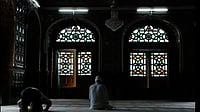With the formation of the Union Territory of Ladakh in 2019, there was a sense of satisfaction in the Buddhist-majority area of Leh that its long-standing demand had been fulfilled at last. Even when Kargil was protesting, Leh celebrated. However, two years later, there is much anxiety and restlessness not only in Leh but the whole of Ladakh. This anxiety is about the rights of natives of Ladakh in relation to employment and land; about the influx of outsiders and erosion of local culture, ecology and heritage; and most importantly, about the lack of political representation.
That everything is not fine in Leh was clearly indicated in September 2020, when most of the Leh-based social and political organisations gave a call to boycott the polls for the Ladakh Autonomous Hill Development Council (LAHDC) till the Sixth Schedule of Constitution is granted for Ladakh and each of the two districts is granted councils on the lines of the autonomous Bodoland Territorial Council in Assam. In pursuit of this demand, all Leh-based parties—including the BJP, Congress and AAP—formed the People’s Movement for Sixth Schedule. Protests since then have not only intensified but there also have been qualitative changes in the very nature of the demands and the methods pursued. The Leh Apex Body (LAB) of People’s Movement has joined the Kargil Democratic Alliance (KDA) for a common struggle. This is quite unprecedented since Leh and Kargil have a history of bitter opposition to each other’s goals and the two taking contradictory positions on the demand for UT. These two bodies, leaving the traditional rivalries of Leh and Kargil behind, have launched a joint front with four major demands—full-fledged statehood with constitutional safeguards, residentship certificates on the lines of state subjects to the people instead of domicile, two seats in Lok Sabha and one in Rajya Sabha for Ladakh, and immediate filling up of vacancies of government jobs. In support of these demands, the LAB and KDA jointly gave a shutdown call in December 2021, which received an overwhelming response both in Leh and Kargil.
An analysis of Ladakh’s struggle, as it evolved in the post-reorganisation phase, makes for very interesting reading. When compared to the earlier struggle for UT, one can notice two significant changes. One, the exclusive nature of the demand of UT as representing only the Buddhists of Leh (to the exclusion of Muslims of Kargil) has given way to a more inclusive politics. Instead of a sectarian basis of Ladakhi identity and its division between Buddhists of Leh and Muslims of Kargil, a secular pan-Ladakhi identity has been asserted. Second, for the first time, a federal turn has been given to Ladakhi politics. This despite the fact that the movement for UT has been a long drawn one.

It is pertinent to note that the demand for UT in Ladakh did not have a federal basis and, on the contrary, emerged out of the logic and urge of centralisation. Seeking to deal with the neglect and disempowerment of Ladakh vis-a-vis the power centre at the state level, Ladakhi leaders (the Buddhists of Leh) had been demanding separation from J&K, mainly from Kashmir. The demand for UT, though raised during the 1989 agitation led by the Ladakh Buddhist Association (LBA), was linked with its decade-old aspiration of being separated from Kashmir and instead being directly controlled by the Centre. Articulated in the context of a binary drawn between the Buddhists and Muslims on the one hand, and anxieties of conflict politics in which Kashmir was embroiled, on the other, the Ladakhi Buddhist leaders had made a direct representation to Maharaja Hari Singh in 1947 giving three preferences—that Ladakh be directly ruled by the Maharaja; or that it be merged with Hindu-majority areas of Jammu or be given the permission to join East Punjab. By another representation to Nehru, the Ladakhi leaders had sought separation of Ladakh from Kashmir on the ground of the distinct identity of Ladakh and its people. When Ladakh briefly came under the direct control of the Centre during the Chinese war, there was a demand for continuation of the control by the Centre. The Ladakhi Buddhist leadership continued to make demands of central administration in Ladakh on the lines of the North East Frontier Agency (NEFA).
With separation from (Muslim) Kashmir as the basic logic of the demand of UT, the politics around the demand for UT suffered not only from its urge for centralisation but also from its sectarian basis. It was a chain reaction of this demand on a religious basis that the politics of Kargil also acquired a sectarian logic. The fear that a separate UT for Ladakh will marginalise the Muslims of Kargil, Kargil sought support from Kashmir and comfort from being part of ‘Muslim-majority’ Jammu and Kashmir.
It was after the formation of UT of Ladakh in 2019 that the limitation of the logic of centralisation could be gauged by the Ladakhi leaders. While there suddenly emerged a feeling of vulnerability after the withdrawal of protections provided by Article 35 A (especially the privileges that Ladakhis enjoyed as permanent residents of J&K state in terms of ownership of land and state employment), there developed a feeling of powerlessness due to the lack of political representation. Unlike the UT of J&K, the UT of Ladakh is without a legislature.
ALSO READ: Federalism And The Idea Of Regionalism
As part of J&K, Ladakh was fairly represented in the state—apart from one MP, there were four MLAs and two MLCs and invariably a minister in the state government. And as party members, Ladakhis were also represented in various other bodies of the state. After the formation of UT, it has only a single member of Parliament through whom people are connected with political decision-making. The new system provides centralised and remote administration. Other than the Lieutenant Governor, all decision-making related to Ladakh is directly at the level of the home minister of India. The hill councils are there, but these have become ineffective in the context of larger bureaucratisation and centralisation.
It is in this context that one can appreciate the federal turn in Ladakh’s politics, based on the urge for greater control over resources and greater say in development. Adopting pan-Ladakhi identity, its politics has not only shed its sectarian character but has got rooted in the sense of partnership between Leh and Kargil, the two major sub-regions of Ladakh. The limited success of this politics is already visible as it has restrained the Centre from introducing the kind of central laws that have already been extended to the UT of J&K (including the new domicile law and new land policy). Rather than extending these laws to Ladakh, the central government has almost recognised the sanctity of the Permanent Resident Certificate by reserving non-government jobs for residents of Ladakh. The Ladakh Resident Certificate Order, 2021 clearly defines those people as residents of Ladakh who possess the Permanent Resident Certificate or are eligible for the same. As the situation stands, of the two newly-created UTs, it is Ladakh that is fighting the processes of centralisation more successfully.
(This appeared in the print edition as "Sharp U-turn in the Hills")
(Views expressed are personal)
ALSO READ
Rekha Chowdhary is Senior fellow, centre for multilevel federalism, Delhi






















